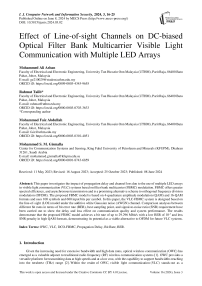Effect of Line-of-sight Channels on DC-biased Optical Filter Bank Multicarrier Visible Light Communication with Multiple LED Arrays
Автор: Mohammed Ali Asban, Rahmat Talib, Mohammad Faiz Abdullah, Mohammed S.M. Gismalla
Журнал: International Journal of Computer Network and Information Security @ijcnis
Статья в выпуске: 3 vol.16, 2024 года.
Бесплатный доступ
This paper investigates the impact of propagation delay and channel loss due to the use of multiple LED arrays in visible light communication (VLC) systems based on filter bank multicarrier (FBMC) modulation. FBMC offers greater spectral efficiency, and asynchronous transmission and is a promising alternative scheme to orthogonal frequency division modulation (OFDM). The proposed FBMC model is based on 4-quadrature amplitude modulation (QAM) and 16-QAM formats and uses 100 symbols and 600 input bits per symbol. In this paper, the VLC-FBMC system is designed based on the line-of-sight (LOS) model under the additive white Gaussian noise (AWGN) channel. Comparison analyses between different bit rates in terms of bit error rate (BER), best sampling point, and signal-to-noise ratio (SNR) requirement have been carried out to show the delay and loss effect on communication quality and system performance. The results demonstrate that the proposed FBMC model achieves a bit rate of up to 29.296 Mbit/s with a low BER of 10-3 and less SNR penalty in high QAM formats, demonstrating its potential as a viable alternative to OFDM for future VLC systems.
OWC, VLC, DCO-FBMC, Propagation Delay, Bit RateBER
Короткий адрес: https://sciup.org/15019281
IDR: 15019281 | DOI: 10.5815/ijcnis.2024.03.02
Текст научной статьи Effect of Line-of-sight Channels on DC-biased Optical Filter Bank Multicarrier Visible Light Communication with Multiple LED Arrays
Given the increasing need for extensive bandwidth and high data rates, optical wireless communication (OWC) has emerged as a valuable adjunct to traditional radio frequency (RF) wireless communication systems [1]. OWC provides a versatile platform for transmitting data at high speeds and at a low cost, with the capability to support bandwidths reaching into the terahertz (THz) range [2]. Within the realm of OWC, visible light communication (VLC) stands out as a distinctive branch that harnesses the power of white light-emitting diodes (LEDs) for optical communication [3].
VLC holds substantial promise for a range of 6G applications, including underwater networks and indoor communication, primarily due to its capacity for high-speed signal transmission and its exploitation of open-spectrum resources [4, 5]. In the VLC system, a fundamental technique at play is the intensity modulation direct detection (IM/DD) approach, which is employed for both transmitting and receiving signals. This technique entails that the signal must maintain a unipolar and real nature, distinguishing it from the conventional bipolar signals commonly utilized in RF communication [6, 7]. Numerous parameters have been thoroughly examined to optimize the performance of VLC systems and facilitate high-speed communication. These parameters encompass multiple LED transmitters, bit rates, delay, system complexity, modulation techniques, and bit-error-rate (BER) considerations. For the enhancement of brightness uniformity and improved energy reception within indoor VLC setups, the deployment of multiple LED arrays has been a popular strategy, with the four-LED array configuration emerging as a prevalent choice [8, 9]. Nevertheless, the utilization of LED arrays in indoor VLC channels presents challenges, notably concerning issues like multipath propagation and intersymbol interference (ISI). ISI is a noteworthy concern in OWC and VLC systems, stemming from various factors such as signal delay, the incorporation of multiple LED arrays, and high bit rates. This phenomenon has the potential to degrade system performance and result in elevated BER levels [10]. In a study conducted by Aydin et al. [11] a performance assessment of a VLC system was carried out, encompassing various LED arrays, notably the widely used four-lamp model. The evaluation focused on critical parameters, including received power, root mean square (RMS) delay, and bit rates. The findings from this study demonstrated that the utilization of extensive LED arrays can result in heightened intersymbol interference (ISI), subsequently leading to increased delay and signal loss. However, it's noteworthy that the research primarily employed the on-off keying (OOK) modulation scheme, which falls within the domain of single-carrier modulation techniques. To address the challenges posed by ISI and to achieve superior data rates, the VLC system has since embraced multi-carrier modulation techniques, such as filter bank multicarrier (FBMC) and orthogonal frequency division multiplexing (OFDM) schemes. These innovations have proven effective in mitigating ISI-related issues and enhancing data transmission rates [12, 13].
FBMC is recognized as a promising scheme for future wireless communications systems, particularly in the realms of OWC and VLC. It is distinguished by its superior spectral efficiency and remarkable resilience to the challenges posed by ISI [14, 15]. Recent research endeavors have demonstrated that FBMC surpasses the well-established OFDM scheme in terms of spectral efficiency, marking a significant advancement in the field of wireless communication [16, 17]. Furthermore, in contrast to OFDM, FBMC adopts a distinctive approach by employing offset quadrature amplitude modulation (OQAM/FBMC) in conjunction with a prototype filter. This strategic choice leads to a multitude of advantages, including enhanced spectral efficiency, reduced out-of-band radiations, support for asynchronous transmission, and the attainment of lower spectral sidelobes, all of which collectively contribute to its prominence in the domain of wireless communication. Kumar et al. [18] conducted an extensive examination and comparison of the BER performance and spectral efficiency between optical OFDM and optical FBMC within the framework of VLC systems. Their analysis unveiled that optical FBMC outperformed OFDM, offering a 0.96 dB enhancement in power efficiency and a 20% increase in spectral efficiency when incorporating a 25% cyclic prefix (CP). These superior qualities of FBMC have drawn significant attention in the literature, with considerations for its application in 5G, 6G communication, and Internet of Things (IoT) systems [19-21]. To harness the potential of FBMC in optical wireless systems and produce the optical domain (unipolar) of the FBMC signal, various FBMC schemes have been explored. Among these are the DC-biased optical FBMC (DCO-FBMC) and flip-FBMC approaches [22]. In a related study in [23], the focus was on BER analysis, taking into account channel delay (attenuation) and employing DCO-FBMC for the VLC system. This analysis resulted in improved BER performance. However, it's essential to note that this improvement was achieved using a single transmitter located at a mere 20 cm distance from the receiver side. Furthermore, the study in [24] provided a performance analysis of optical FBMC-VLC in terms of bandwidth efficiency, power efficiency, and complexity under the influence of noise. Nevertheless, this research did not delve into the specific impact of propagation delay stemming from multiple transmitters on the performance of FBMC.
The existing body of literature reveals a conspicuous gap in research that comprehensively investigates the ramifications of channel propagation delay and losses arising from multiple transmitters on the performance of optical FBMC (DCO-FBMC) modulation, within the framework of VLC systems. This paper's primary contribution lies in addressing this gap. It offers a rigorous evaluation of an optical FBMC model-based VLC system. This assessment meticulously considers the effect of propagation delay and channel loss parameters, using a four-LED array model representative of indoor applications. Additionally, the study employs a range of metrics, including bit rate, optimal sampling points, various QAM formats, and SNR, to thoroughly assess and analyse the system's BER performance and overall communication quality. Furthermore, the research delves into the influence of different bit rates on the BER performance within the optical FBMC-based VLC system. This examination provides insights into how variations in bit rate affect system performance.
The rest of this paper is structured as follows: Section 2 illustrates the previous literature related to this work. Section 3 includes the VLC system model and equations used to analyse and evaluate the optical FBMC system performance. Section 3 presents the findings and analysis of various QAM formats at different bit rates. Finally, the conclusion of this work is drawn in Section 4.
2. System Model
The schematic of the proposed simulation DCO-FBMC-based VLC system is presented in Fig. 1. First, the input data is fed into the symbol mapping where an OQAM signal mapper is used for signal processing and the symbol is filtered using a prototype filter. The signal is then up-sampled and subjected to an inverse fast Fourier transform (IFFT) with length of 1024 to produce a time-domain signal x ( t ) which consists of the N symbol period, and is expressed as [25]:
NM
x ( t ) = SZ a m , n g m , n ( t ) n = 1 m = 1
Where M is the IFFT length (subcarrier), m denotes the subcarrier index, n is the n-th symbol, ɑ m,n is the symbol transmitted, and the function g ( t ) is used in FBMC synthesis to transform ɑ m,n into the signal space; g ( t ) .
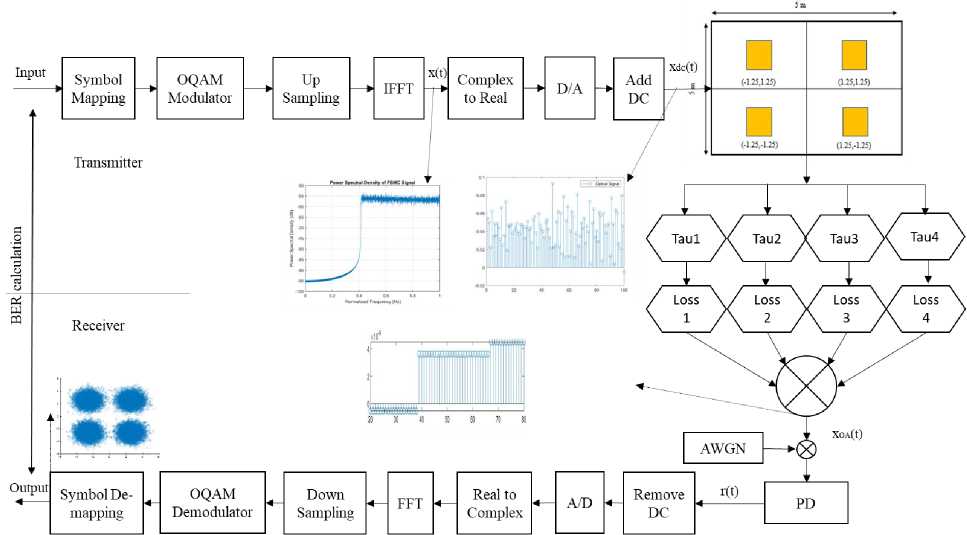
Fig.1. DCO-FBMC block diagram
Since FBMC-VLC utilizes the IM/DD modulation method, the signal in the time domain in eq.1 should be real and positive (unipolar). Thus, the output complex signal x ( t ) is transformed into the real signal x ( t ) as proposed in [26]. Subsequently, the positive signal is obtained by adding the DC bias as [27]:
x dc ( t ) = XR ( t ) + C^2
where C is a positive integer and a 2 is the variance of x ( t ). Hence, the optical signal for a transmitter becomes:
xo ( t ) = h ( t ) * x dc ( t )
where h ( t ) is the channel impulse response (CIR). To represent line-of-sight (LOS) optical channels for indoor applications, a linear model that includes attenuation and delay is used. In optical LOS channels, the attenuation of the signal relies on the inverted square of the distance separating the light source and the recipient, and the impulse response is expressed as [28]:
h ( t ) = L^( t - т )
where Lloss is the LOS channel loss and is used as in [29], and т is the signal propagation delay expressed by:
D
т = — c where D is the distance between the light source and the PD of the receiver, and c denotes the symbol of the speed of light. As a result, the overall received optical signal for the four transmitters is:
x OA ( t ) = E x o,i( t )
i = 1
where i indicates the number of transmitters. The transmitted signal is passed through the optical LOS channel and the AWGN channel. Afterward, at the receiver side, is the reverse process. The PD receives the signal and converts it to electrical form r(t) expressed by:
r ( t ) = x OA ( t ) + n ( t )
where n ( t ) indicates the noise of additive white Gaussian. The optimal sampling point of the received signal, where low BER occurs, is then determined by performing the sampling process. The DC bias is then eliminated before the received signal is converted back into the complex domain. After that, the matched filter processes the signal and then it undergoes FFT operation, down-sampling, OQAM demodulation, and signal de-mapping to retrieve the original signal. Finally, the received data is compared bit-to-bit with the input data to calculate system BER performance.
The proposed optical FBMC system is simulated in MATLAB. The 4-QAM and 16-QAM formats are implemented at overlapping factors (k) of 4, 100 symbols, and 600 input bits. The 4-QAM and 16-QAM formats are designed with an FFT length of 1024 points and 512 points, respectively as shown in Table 1, and the 64, and 256-QAM are executed with 2048 FFT length to maintain the same input capacity (600 bit/symbol). Additionally, to obtain a minimum 1-bit error over 60000 transmitted bits, 16-QAM is evaluated at an SNR of 17 dB whereas 4 QAM is tested at an SNR of 9 dB. The performance analysis has been conducted for three different bit rates at the direct received location (1.25,1.25) below Lamp 2 which has the highest received power and SNR due to the short distance between transmitter and receiver.
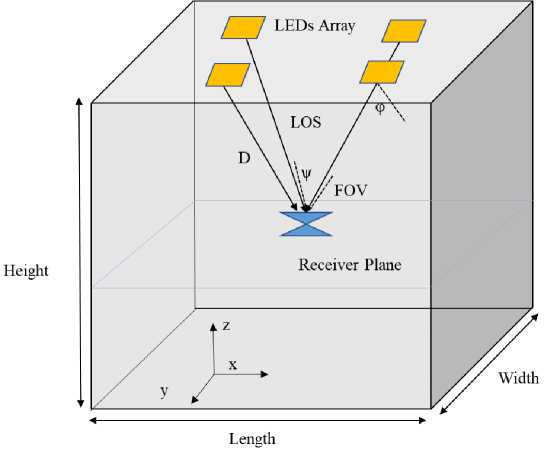
Table 1. Simulation parameters of DCO-FBMC
|
Symbol Format |
FFT Length |
FBMC Signal length/symbol |
Symbol Period (И |
Bit Rate (Mbit/s) |
|
4-QAM |
1024 |
8192 |
81.92 |
7.324 |
|
40.96 |
14.648 |
|||
|
20.48 |
29.296 |
|||
|
16-QAM |
512 |
4096 |
81.92 |
7.324 |
|
40.96 |
14.648 |
|||
|
20.48 |
29.296 |
Fig.2. VLC system model for a typical room
In the current work, the VLC model and typical room specification as given in [30] have been adopted and integrated with the proposed method of four LEDs arrays model to investigate the LOS effect. The proposed VLC model calculates the channel loss and propagation delay for a typical 5 × 5 × 3 m3 room which consists of 2×2 LED arrays put on the ceiling at 3 m height with positions of (-1.2 5, -1.25) and (1.25, 1.25), (-1.25, 1.25), (1.25, -1.25); each LED array contains 60 × 60 LEDs, as shown in Fig. 2. The proposed VLC system parameters are shown in Table 2.
Table 2. VLC System model parameters
|
Model parameter |
Value |
|
Room Dimensions |
5 x 5 x 3 m |
|
Number of lamps |
4 |
|
Number of LEDs per lamp |
(60 x 60) = 3600 |
|
Receiver FOV |
70 degrees |
|
Semi-angle at half power |
70 degrees |
|
Area of PD |
1.0 cm2 |
|
Gain of the optical concentrator |
2.548 |
3. Simulation Result and Discussion
In this study, FBMC/OQAM in a VLC system with the 4-QAM and 16-QAM format has been designed inside a room based on the characteristics in Table 2. The system simulation is conducted under the effect of AWGN channel, time delay, and channel loss due to the multiple lamps (2 × 2 LED arrays). The BER performance of the FBMC model is then assessed for the 4-QAM and 16-QAM formats with 100 symbols and 600 bits of input per symbol.
-
3.1. Recovering the DCO-FBMC Signal
In this section, we discuss the recovery of the FBMC signal after applying the delay and loss along with the optimal sampling window for obtaining low BER values. To assess the performance of the FBMC system, it is necessary to first acquire the output for the propagation delay and channel loss at the received position (1.25, 1.25) as shown in Table 3. It is visible that the propagation delay and the channel loss are minimal when considering Lamp 2, which is direct to the received point. However, the delay and loss steadily increased when taking into account Lamps 3 and 4, as well as Lamp 1. This is because of the channel effect and the large distance between the received point and the transmitters resulting in a high delay and loss.
Table 3. The output of the propagation delay and channel loss
|
Transmitter Location (m) |
Lamp 1 (-1.2 5, -1.25) |
Lamp 2 (1.2 5, 1.25) |
Lamp 3 (1.2 5, -1.25) |
Lamp 4 (-1.2 5, 1.25) |
|
delay (ns) |
13.8 |
7.2 |
10.9 |
10.9 |
|
Channel loss (dB) |
62.8 |
52.5 |
59.2 |
59.2 |
Here, as shown in Fig. 3, the BER performance at the optimal sampling point within the sample time length of the FBMC signal is examined. 4-QAM and 16-QAM formats' performance is assessed at bit rates of 7.324 Mbit/s, 14.648 Mbit/s, and 29.296 Mbit/s. The optimal sampling range for the 7.324 Mbit/s bit rate was at a sampling time greater than 3.9 ns, resulting in minimum BER values of 10-5 and 0 for 4-QAM and 16-QAM formats respectively. However, at a sampling time lower than 3.9 ns both 4-QAM and 16-QAM formats exhibit high BER values due to channel effect and light interference from other lamps. The best BER performance at a bit rate of 14.648 Mbit/s is found at a sampling time greater than 3.8 ns when a BER of 0 is attained in 16-QAM and 10-5 in 4-QAM. Conversely, the system performance degraded when the sampling time was 3.8 ns or less. Additionally, when the bit rate rises to 29.296 Mbit/s, the 4-QAM communication link fails over the entire sampling period while in 16-QAM the best BER performance occurs after time reaches 3.8 ns with a BER of 10-5. Hence, even at higher bit rates, 16-QAM can achieve the minimum BER at the same SNR of 17 dB, which cannot be achieved by 4-QAM. These observations are illustrated in Fig. 3.
Based on Table 1 parameters, Table 4 displays the optimal sampling time range, with 4-QAM and 16-QAM at bit rates of 7.324 Mbit/s, 14.648 Mbit/s, and 29.296 Mbit/s achieving the lowest BER value. Fig. 4 illustrates the 4-QAM and 16-QAM communication quality for the FBMC signal at bit rates of 7.324 Mbit/s, 14.648 Mbit/s, and 29.296 Mbit/s. Fig. 4 (a) shows the constellation diagram for the worst sampling time range in the 4-QAM format, where the communication is poor and BER is higher than x10-3, for bit rates of 7.324 Mbit/s and 14.648 Mbit/s. The signal constellation diagram, however, may be seen to have improved at the best sampling point with a BER less than x10-3, as shown in Fig. 4. (b). At a bit rate of 29.296 Mbit/s in the 4-QAM, the constellation diagram is bad due to the communication has failed as seen in Fig. 4 (e). At the worst sampling time range in 16-QAM format, the communication likewise failed with a BER of less than x10-2 at bit rates of 7.324 Mbit/s, 14.648 Mbit/s, and 29.296 Mbit/s, as shown by the constellation diagram in Fig. 4 (c). At the optimal sample point, the constellation diagram is improved in 16-QAM with a BER of x10-4 as in Fig. 4 (d). Through the constellation diagram, the suggested FBMC simulation approach successfully assesses communication performance.

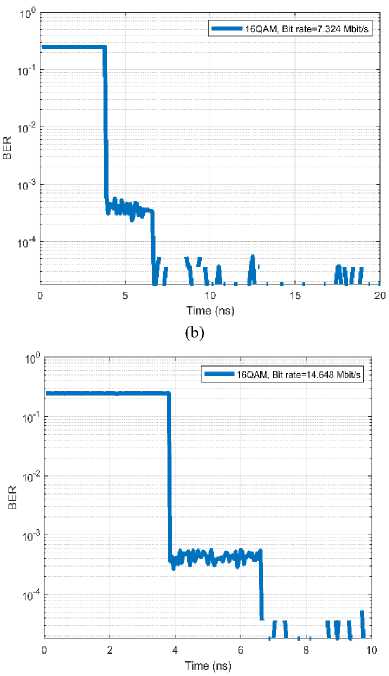
(d)
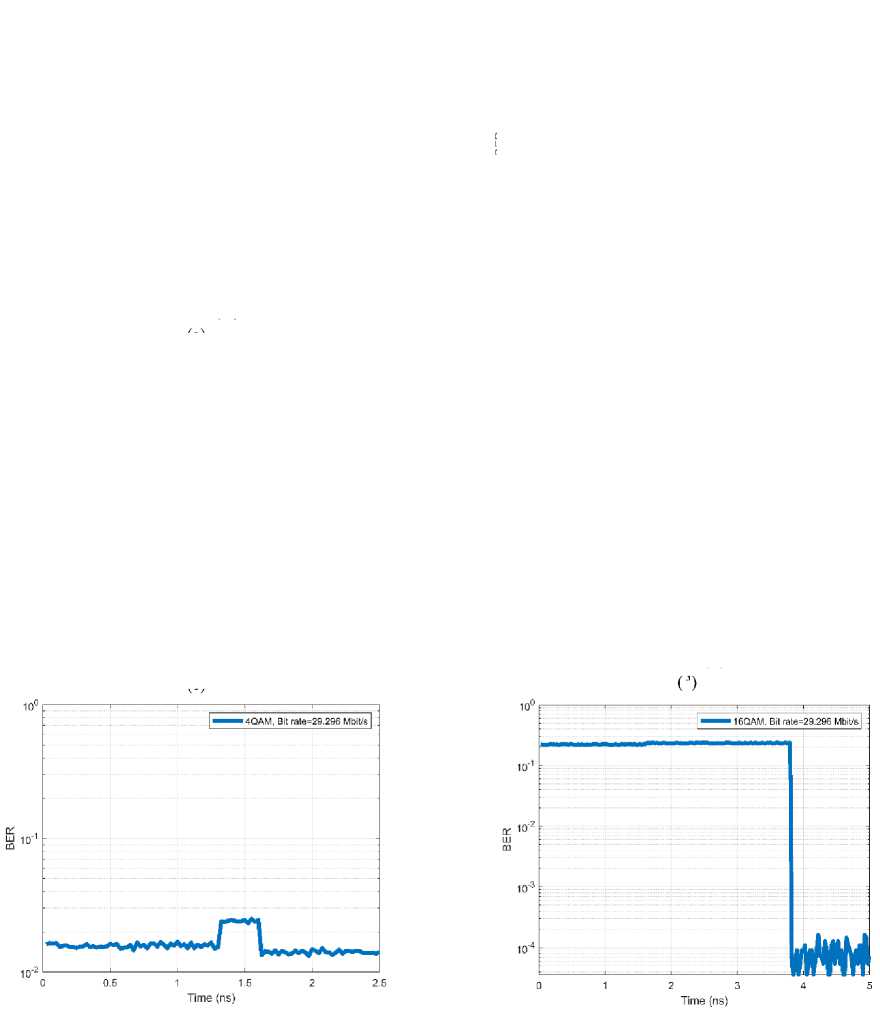
(e)
(f)
Fig.3. BER performance during sampling time for (a) 4-QAM, bit rate of 7.324 Mbit/s, (b) 16-QAM, bit rate of 7.324 Mbit/s, (c) 4-QAM, bit rate of 14.648 Mbit/s, (d) (c) 16-QAM, bit rate of 14.648 Mbit/s, (e) (c) 4-QAM, bit rate of 29.296 Mbit/s, (f) (c) 16-QAM, bit rate of 29.296 Mbit/s
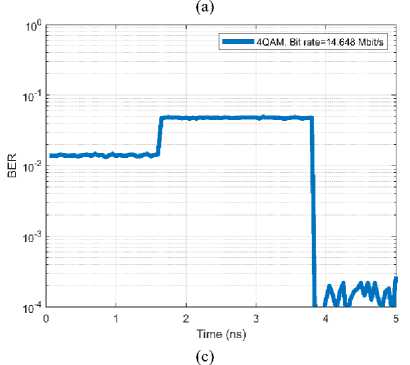
Table 4. Best sampling time range vs BER
|
QAM Format |
Bit Rate Mbit/s |
Low BER Range |
||
|
Sample time Range (ns) |
Min. BER |
Max. BER |
||
|
4-QAM |
7.324 |
3.9 – 10 |
5.435x10-5 |
3.442x10-4 |
|
14.648 |
3.85 – 5 |
5.435x10-5 |
2.7174x10-4 |
|
|
29.296 |
- |
- |
- |
|
|
16-QAM |
7.324 |
3.9 – 20 |
0 |
6.160x10-4 |
|
14.648 |
3.85 – 10 |
0 |
5.430x10-4 |
|
|
29.296 |
3.825 – 5 |
3.623x10-5 |
1.630x10-4 |
|

(e)
Fig.4. Constellation diagram during the sampling time (a), (b) 4-QAM, (c),(d)16-QAM (e) 4-QAM, bit rate of 29.296 Mbit/s
-
3.2. DCO-FBMC based VLC System Performance
The DCO-FBMC performance at bit rates of 7.324 Mbit/s, 14.648 Mbit/s, and 29.296 Mbit/s under the influence of propagation delay and channel loss for 4, 16, 64, and 256-QAM formats are depicted in Fig. 5. It can be observed that the optical FBMC system performs well at bit rates of 7.324 Mbit/s and 14.648 Mbit/s for all QAM formats, but that higher QAM formats require higher SNR to attain the same performance. On the contrary, at a high bit rate of 29.296 Mbit/s, the system performance degraded in 4-QAM format with BER of 10-2 even at high SNR values, however in higher QAM formats, the FBMC-VLC system performance remained strong and a BER less than 10-3 were reached in comparison to 4-QAM. This is because high QAM formats have a smaller FFT length, allowing them to suppress ISI’s effect.

(a)

(b)

Fig.5. BER performance for DCO-FBMC of various QAM formats at bit rates of (a) 7.324 Mbit/s, (b) 14.648 Mbit/s, and (c) 29.296 Mbit/s
4. Conclusions
Acknowledgement
This research was supported by Ministry of Higher Education (MOHE) through Fundamental Research Grant Scheme (FRGS) (FRGS/1/2020/TK0/UTHM/03/36).
Список литературы Effect of Line-of-sight Channels on DC-biased Optical Filter Bank Multicarrier Visible Light Communication with Multiple LED Arrays
- M. Hosney, H. A. Selmy, A. Srivastava, and K. M. Elsayed, "Interference mitigation using angular diversity receiver with efficient channel estimation in MIMO VLC," IEEE Access, vol. 8, pp. 54060-54073, 2020. doi: 10.1109/ACCESS.2020.2981137.
- G. A. Mapunda, R. Ramogomana, L. Marata, B. Basutli, A. S. Khan, and J. M. Chuma, "Indoor Visible Light Communication: A Tutorial and Survey," Wireless Communications and Mobile Computing, vol. 2020, p. 8881305, 2020/12/11 2020, doi: 10.1155/2020/8881305.
- T.-C. Yu, W.-T. Huang, W.-B. Lee, C.-W. Chow, S.-W. Chang, and H.-C. Kuo, "Visible light communication system technology review: Devices, architectures, and applications," Crystals, vol. 11, no. 9, p. 1098, 2021. doi: 10.3390/cryst11091098
- N. Chi, Y. Zhou, Y. Wei, and F. Hu, "Visible light communication in 6G: Advances, challenges, and prospects," IEEE Vehicular Technology Magazine, vol. 15, no. 4, pp. 93-102, 2020. doi: 10.1109/MVT.2020.3017153
- L. E. M. Matheus, A. B. Vieira, L. F. Vieira, M. A. Vieira, and O. Gnawali, "Visible light communication: concepts, applications and challenges," IEEE Communications Surveys & Tutorials, vol. 21, no. 4, pp. 3204-3237, 2019. doi: 10.1109/COMST.2019.2913348
- D. W. Dawoud, F. Héliot, M. A. Imran, and R. Tafazolli, "A novel unipolar transmission scheme for visible light communication," IEEE Transactions on Communications, vol. 68, no. 4, pp. 2426-2437, 2019. DOI: 10.1109/TCOMM.2019.2963377
- Z. Ghassemlooy, L. N. Alves, S. Zvanovec, and M.-A. Khalighi, Visible light communications: theory and applications. CRC press, 2017. doi: 10.1201/9781315367330
- N. E. Mahfouz, H. A. Fayed, A. Abd El Aziz, and M. H. Aly, "Improved light uniformity and SNR employing new LED distribution pattern for indoor applications in VLC system," Optical and Quantum Electronics, vol. 50, pp. 1-18, 2018. doi: 10.1007/s11082-018-1618-6
- T. Ganjian, G. Baghersalimi, and Z. Ghassemlooy, "Performance evaluation of the received power based on the transmitter position in a visible light communications system," in 2017 Iranian Conference on Electrical Engineering (ICEE), 2017: IEEE, pp. 1763-1768. doi: 10.1109/IranianCEE.2017.7985336
- Y. S. Hussein, M. Y. Alias, and A. A. Abdulkafi, "On performance analysis of LS and MMSE for channel estimation in VLC systems," in 2016 IEEE 12th International Colloquium on Signal Processing & Its Applications (CSPA), 2016: IEEE, pp. 204-209. doi: 10.1109/CSPA.2016.7515832.
- B. Aydin and Ç. Duman, "Comparison of OOK-RZ and 4-PPM performances in Li-Fi systems using LED arrays," Optics & Laser Technology, vol. 153, p. 108247, 2022. doi: 10.1016/j.optlastec.2022.108247
- S. Kumar and P. Singh, "Spectral efficient asymmetrically clipped hybrid FBMC for visible light communication," International Journal of Optics, vol. 2021, pp. 1-8, 2021. doi: 10.1155/2021/8897928
- A. E. Ibhaze, P. E. Orukpe, and F. O. Edeko, "High capacity data rate system: Review of visible light communications technology," Journal of Electronic Science and Technology, vol. 18, no. 3, p. 100055, 2020. doi: 10.1016/j.jnlest.2020.100055
- K. K. Vaigandla and J. Benita, "Study and analysis of multi carrier modulation techniques–FBMC and OFDM," Materials Today: Proceedings, vol. 58, pp. 52-56, 2022. doi: 10.1016/j.matpr.2021.12.584.
- S. Alshami, "Performance Analysis of OFDMA, UFMC, and FBMC for Optical Wireless Communication," in 2021 1st International Conference on Emerging Smart Technologies and Applications (eSmarTA), 2021: IEEE, pp. 1-4. DOI: 10.1109/eSmarTA52612.2021.9515739
- P. Kansal and A. K. Shankhwar, "FBMC vs OFDM waveform contenders for 5G wireless communication system," Wireless Engineering and Technology, vol. 8, no. 4, pp. 59-70, 2017. doi: 10.4236/wet.2017.84005.
- D. Mattera, M. Tanda, and M. Bellanger, "Comparing the performance of OFDM and FBMC multicarrier systems in doubly-dispersive wireless channels," Signal Processing, vol. 179, p. 107818, 2021. doi: 10.1016/j.sigpro.2020.107818
- S. Kumar and P. Singh, "Filter bank multicarrier modulation schemes for visible light communication," Wireless Personal Communications, vol. 113, no. 4, pp. 2709-2722, 2020. doi: 10.1007/s11277-020-07347-6.
- S. S. Oyewobi, K. Djouani, and A. M. Kurien, "Visible light communications for internet of things: Prospects and approaches, challenges, solutions and future directions," Technologies, vol. 10, no. 1, p. 28, 2022. doi: 10.3390/technologies10010028
- H. H. H. Mahmoud, A. A. Amer, and T. Ismail, "6G: A comprehensive survey on technologies, applications, challenges, and research problems," Transactions on Emerging Telecommunications Technologies, vol. 32, no. 4, p. e4233, 2021. doi: 10.1002/ett.4233
- Ali J. Ramadhan, "Overview and Comparison of Candidate 5G Waveforms: FBMC, UFMC and F-OFDM", International Journal of Computer Network and Information Security, Vol.14, No.2, pp.27-38, 2022.
- M. S. Bahaaelden, B. Ortega, R. Perez-Jimenez, and M. Renfors, "Efficiency analysis of a truncated flip-FBMC in burst optical transmission," IEEE Access, vol. 9, pp. 100558-100569, 2021. DOI: 10.1109/ACCESS.2021.3096660
- R. Chen, K.-H. Park, C. Shen, T. K. Ng, B. S. Ooi, and M.-S. Alouini, "Visible light communication using DC-biased optical filter bank multi-carrier modulation," in 2018 global LIFI congress (GLC), 2018: IEEE, pp. 1-6. doi:10.23919/GLC.2018.8319094
- J. Dang, Z. Zhang, L. Wu, and L. Guo, "DC and non-DC biased optical filter bank multicarrier communication for IM/DD channel," in 2016 IEEE international conference on communications workshops (ICC), 2016: IEEE, pp. 423-429. doi: 10.1109/ICCW.2016.7503824.
- R. Nissel, M. Rupp, and R. Marsalek, "FBMC-OQAM in doubly-selective channels: A new perspective on MMSE equalization," in 2017 IEEE 18th International Workshop on Signal Processing Advances in Wireless Communications (SPAWC), 2017: IEEE, pp. 1-5. doi: 10.1109/SPAWC.2017.8227806.
- A. A. Qasim, M. Abdullah, and R. Talib, "Adaptive DCO-FBMC in Visible Light Communication," in IOP Conference Series: Materials Science and Engineering, 2020, vol. 767, no. 1: IOP Publishing, p. 012018. DOI: 10.1088/1757-899X/767/1/012018
- L. Wu, Z. Zhang, J. Dang, and H. Liu, "Adaptive modulation schemes for visible light communications," Journal of Lightwave Technology, vol. 33, no. 1, pp. 117-125, 2014. doi: 10.1109/JLT.2014.2374171.
- A. Al-Kinani, C.-X. Wang, L. Zhou, and W. Zhang, "Optical wireless communication channel measurements and models," IEEE Communications Surveys & Tutorials, vol. 20, no. 3, pp. 1939-1962, 2018. DOI: 10.1109/COMST.2018.2838096
- M. Obeed, A. M. Salhab, M.-S. Alouini, and S. A. Zummo, "On optimizing VLC networks for downlink multi-user transmission: A survey," IEEE Communications Surveys & Tutorials, vol. 21, no. 3, pp. 2947-2976, 2019. DOI: 10.1109/COMST.2019.2906225
- Z. Ghassemlooy, W. Popoola, and S. Rajbhandari, Optical wireless communications: system and channel modelling with Matlab®. CRC press, 2019. doi.org/10.1201/9781315151724

